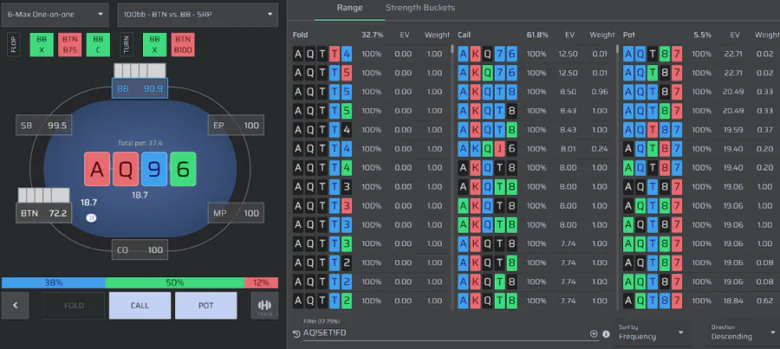PLO5 Poker Strategy

-
T&Cs Apply | Play Responsibly | GambleAware
18+ | Play Responsibly | T&C Apply
-
T&Cs Apply | Play Responsibly | GambleAware
+18 / T & C apply / Play responsible

- Fact Checked by: PokerListings
- Last updated on: July 22, 2025 · 8 minutes to read
With the emergence of solvers, widespread poker strategy content and fears of online opponents utilizing real time assistance (RTA), the landscape for progression in No Limit Hold’em has gone a little stale. The glory days of nosebleed online cash games full of eccentric gamblers are merely a faint haze in the rear view mirror. Today’s scene has motored into well oiled and highly studied mathematical and theoretical geniuses battling for any tiny edge they can get their hands on. This begs the question; ‘Where is the value these days in poker? In this article I will present exhibit A, the great game of Pot Limit Omaha 5 cards (PLO5).
Why PLO5 is Sexier Than Hold’em
The beauty of holding 5 cards as opposed to 2 lies in the following:
More Playability in PLO5
Simply put, holding more cards means more chances to hit. The equities between hands run a lot closer in PLO5, so it is in fact correct to continue almost our entire range when facing a 3bet out of position. In Hold’em never folding to 3bets is a massive leak that would cost us a lot of real money. Having to fold all the time is boring – PLO5 allows you to treat yourself to seeing more flops!
Less Widespread Understanding of the Game
In Hold’em even the guy playing for beer money at the local pub knows he should probably fold a lot of off-suit hands to a 3 bet. In PLO5 the only solvers publicly available are not comprehensive and have not had the same effect on the general playstyle as we’ve seen develop in Hold’em over the years. It is very common to see VPIPs of well above 50 from multiple players on PLO5 tables. Every hand looks somewhat appetizing but with discipline and a principled preflop approach you can already forge a sizeable edge on your opponents.
More All-Ins, More Action
In Hold’em you will completely whiff the flop about two-thirds of the time. In PLO5 there are so many ways to connect with the board. It’s rather exciting to think of a poker game that allows you to have top set, the nut flush draw and the nut straight draw…all at the same time!
Americas Cardroom
T&Cs Apply | Play Responsibly | GambleAware
18+ | Play Responsibly | T&C Apply
The Basics
For those completely new to the game I will outline some of the basics:
- Whilst we have the option across multiple streets to connect with the board using all 5 of our cards, we ultimately must use 2 at showdown. This can offer some confusion to novice players in the following situations
Our hand: As Th Tc 8h 7c
The board: Ks 8s 5s 7s 4c
Having the As in No Limit Hold’em would usually mean we hold the nut flush, but in PLO5 we must use 2 cards from our hand. In this case we hold a much weaker hand in the form of 8s and 7s for 2 pair, that will often be beaten.
Our hand: Ac Jh Js 4h 4c
The board: Tc 9c 3s 8h 7s
Here we arrive at the river having missed our nut flush draw and hold only a pair of Jacks, not a straight. Instead of calling off our stack with our supposed straight, we might be better inclined to use our blockers (holding cards that interact with the nut combination of QJ) as a bluff for any chance of winning the pot.
- As the name suggests, Pot Limit Omaha 5 cards (PLO5) utilizes pot limit rules for preflop and postflop betting. This often eliminates the possibility of going all in preflop and allows no over-betting to occur in the postflop phase of each hand.
If you have played in casinos that offer Pot Limit Omaha games you may have wandered past the table and heard someone shouting ‘POT!’, indicating that they want to bet the maximum size available.
To calculate a pot sized raise in preflop betting you must times the last bet by 3 and then add the remaining bet(s) in the pot. For example, if the blinds are $5/10 and you are first to act under the gun then the last bet is the big blind, so the maximum will be 3 * $10 + $5 = $35. It folds to the player on the button who likes the look of his hand and wants to take things upstairs. He bellows ‘POT!’, for him the sizing will be 3 times your bet + the blinds, so 3 * $35 + $10 + $5 = $120. If the players are drinking or the game is situated somewhere in Scandinavia this can often continue until both players are all in, with the same calculations for the following raise sizings.
Calculating the size of the pot for postflop play adopts similar principles. Let’s say we opened to pot in the Cutoff and faced a defense from the Big Blind. The pot is $35 (our raise) + $35 (the call) + $5 (the small blind) = $75. The maximum bet is $75. Should we bet $50 on the flop and face a re-raise to full pot then the raise will be to $225 (3 * $50 + $75).

Betonline Poker
T&Cs Apply | Play Responsibly | GambleAware
T&Cs Apply | Play Responsibly | GambleAware
The Power of Preflop
As there are almost 2.6 million combinations of starting hands in PLO5 there is therefore a heavy emphasis on the importance of preflop hand selection. For novice players it would be advantageous to follow these principles, which I call the 4 Ps: The Pillars to Preflop PLO5 Precision. When getting started in the game I would suggest you to have at least 2 of the following 3 hand categories when entering a pot. This will set a solid foundation for making strong hands that can justify both aggression from our side and face aggression from our opponents.
1. High Pairs
As pairs are so much more prevalent in PLO5 the value of hands like TTxxx & 99xxx drastically decreases in value. When you make a set you’ll want to have top set in order to command a strong equity advantage over a hand like a worse set. So for high pairs we will consider JJ or better to be a good starting point. You would be best off to give AA the highest weighting of importance, scaling down through KK (slightly less), then QQ and JJ.
2. Nut Suits
Holding a nut suit offers a similarly appetizing component to a high pair, as you can seamlessly dominate the worse draws or made hands of your opponents when you hit a flop. An extremely common and difficult situation to face in PLO5 is to make a non nut flush and face aggression over multiple streets on an unpaired board texture, a guessing game of sorts. Their hand will almost always include the nut flush blocker and we have to figure out if they have the side card to hold a higher flush.
Spoiler: due to the sheer number of combinations of nut flushes they often will!
3. Connectivity
Holding more cards in our preflop holding places a premium on having connectivity. We want to be able to flop draws to the nuts. In PLO5 a great place to start is with the JT9 component. Using Hold’em principles we see that when we make a straight with JT, on boards like AKQ, KQ9, Q98 & 987 it is always to the nuts. So having this component in our 5 card holding not only gives us a lot of equity, but playability too!
The Common Pitfalls of PLO5
Bearing in mind the 4 Ps that we just outlined, there are a number of key heuristics to also consider when approaching common situations in PLO5.
Weak Double Suited KK
Hands like KcKh9h6c3d may look like appealing hands but often with the lack of side card connectivity to our set draw (KK) we can get suckered into a big pot with poor upside. When we flop a gut shot with a K high flush draw on say Th 8h 4d, an above average flop for our hand, and see aggression from even 1 opponent it is very common that our draws can be dominated and thus our equity can be extremely low.
Low Connectivity
Preflop holdings such as 76543 double suited look sexy but can be troublesome, especially in multiway confrontations. A common example would be flopping the nuts on a board such as 985 flush draw. We do have the best hand but can be at an equity disadvantage to a wrap and a flush draw, so playing this spot requires a lot of conservatism. This begs the question of what we are doing in the hand in the first place, as we have flopped the nuts but are at the mercy of a plethora of turn cards that could kill our holding.
Naked Top Two Pair
In Hold’em we are often over the moon to flop top two pair on a board with no straight or flush possible. In PLO5 we have to be more mindful, as we can be completely crushed by a set or strong draws. We can use the PLO Mastermind (a PLO5 solver) to showcase a common spot that is often misplayed.
Here we see a board of AhQh9d and face a 75% pot bet on the flop, which we call. The turn brings an offsuit 6 which introduces some additional straight draws. When we face a pot sized bet here holding AQ without a flush draw we are supposed to fold our hand around a third of the time. We can be crushed by AA, QQ of course but we also have to be mindful of having poor equity realisation (successfully navigating to showdown) on a number of rivers versus further aggression.
Play PLO5 Here
-
#1Network: Check the official siteStake.US Casino4.3
- Bonus: $55 Stake Cash + 260K Gold Coins
- Loyalty:
T&Cs Apply | Play Responsibly | GambleAware
18+ | Play Responsibly | T&C Apply
-
#2Network: IndependentLonestar Casino4
- Bonus: $2.99 = 15,000 GC
- Loyalty:
T&Cs Apply | Play Responsibly | GambleAware
T&Cs Apply | Play Responsibly | GambleAware
-
#3Network: Check the official siteCrown Coins Casino4.5
- Bonus: 100,000 CC & 2 FREE SC
- Loyalty:
T&Cs Apply | Play Responsibly | GambleAware
18+ | Play Responsibly | T&C Apply
-
#4Network: IndependentBaba Casino4
- Bonus: GC 500,000 + Free SC 2
- Loyalty:
T&Cs Apply | Play Responsibly | GambleAware
T&Cs Apply | Play Responsibly | GambleAware
-
#5Network: Check the official siteThe Money Factory4.1
- Bonus: First purchase – just $7.49 for 32 SC
- Loyalty:
T&Cs Apply | Play Responsibly | GambleAware
T&Cs Apply | Play Responsibly | GambleAware
-
#6Network: IndependentCazino.com4.1
- Bonus: 9.99% for 20SC +20K LC
- Loyalty:
T&Cs Apply | Play Responsibly | GambleAware
T&Cs Apply | Play Responsibly | GambleAware
-
#7Network: IndependentLuckyBird.io3.6
- Bonus: 1000 GC + 1.8 FREE SC
- Loyalty:
T&Cs Apply | Play Responsibly | GambleAware
T&Cs Apply | Play Responsibly | GambleAware
-
#8Network: IndependentSpinblitz Casino4.2
- Bonus: 7,500 GC, 2.5 SC, and 5 bonus spins
- Loyalty:
T&Cs Apply | Play Responsibly | GambleAware
T&Cs Apply | Play Responsibly | GambleAware
-
#9Network: IndependentSidepot Casino4.1
- Bonus: 10K GC + 1 Sweeps Cash
- Loyalty:
T&Cs Apply | Play Responsibly | GambleAware
T&Cs Apply | Play Responsibly | GambleAware
-
#10Network: IndependentSpinfinite Casino3.3
- Bonus: 200% Extra With Your 1st Purchase+Spin the Welcome Wheel
- Loyalty:
T&Cs Apply | Play Responsibly | GambleAware
T&Cs Apply | Play Responsibly | GambleAware
Conclusion
If you are new to the game I hope you found this article to be informative and can utilize some of these principles successfully to increase your win rate at the tables! The landscape for both live and online PLO5 games is very strong, with lots of loose players and wild action to take advantage of. Good luck!
Related Reading:

Betonline Poker
T&Cs Apply | Play Responsibly | GambleAware
T&Cs Apply | Play Responsibly | GambleAware
-
- 100% up to $2000
T&Cs Apply | Play Responsibly | GambleAware
18+ | Play Responsibly | T&C Apply
-
CoinPoker4.1
- 33% Weekly
- 150% up to 2000$
T&Cs Apply | Play Responsibly | GambleAware
+18 / T & C apply / Play responsible
-
Stake.US Poker4.3
- Rakeback 5%
- $55 Stake Cash + 260K Gold Coins
T&Cs Apply | Play Responsibly | GambleAware
18+ | Play Responsibly | T&C Apply
-
- 100% up to $1000
T&Cs Apply | Play Responsibly | GambleAware
T&Cs Apply | Play Responsibly | GambleAware
-
T&Cs Apply | Play Responsibly | GambleAware
18+ | T&Cs Apply | Play Responsibly | GambleAware



